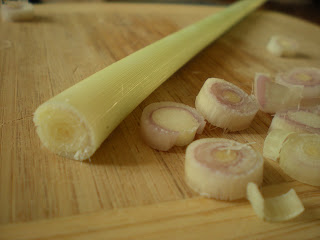
My first trip to England is forever cemented in my palate for this reason. Despite all the tales of culinary shock horror, I was delighted at every table, from my first cup of sweet, milky black tea (which was shocking in its collective consumption) to luscious spoonful of clotted cream. I was also schooled by one particular sandwich at an organic cafe in London; this was in the mid 1990s, when the word "organic" had yet to be uttered by even the most devoted American foodie.
Perhaps a grilled cheese on crusty, whole-grain bread with a fine mist of sweet, shredded carrots and slathering of fresh mango chutney doesn't seem so exotic today, but at the time I'd never tasted anything even remotely like it. One bite of the oozing, pungent cheese and chunky chutney, and everything just made sense: Salty needs sweet for each to shine.

I've been hooked on mango chutney- and tea- ever since that trip, but it's always beneficial to keep exploring. So I finally made this apricot variety, from Madhur Jaffrey's World of the East Vegetarian Cooking (one of my first cookbooks). I just wish I hadn't waited so long- the rich, sweet-tangy taste, studded with plump currants, may be my new favorite.
Even with just some glistening amber dollops on crackers and cheese, it elevates a cup of tea to something fit for a queen.
Apricot Chutney
Makes: 1 1/2 cups.
1/2 pound dried apricots
2 cups hot water
5 cloves garlic, coarsely chopped
1 x 1 1/2-inch piece fresh ginger, coarsely chopped
1/2 cup plus 2 tablespoons red-wine vinegar
3/4 cup sugar
1/4 teaspoon salt
1/8 teaspoon cayenne
1/4 cup dried currants
1. Place apricots in a heavy, medium-size saucepan and pour hot water over. Let soak one hour.
2. With an immersion blender or in food processor, blend garlic, ginger and 2 tablespoons of the vinegar until smooth. Spoon into saucepan along with remaining vinegar, sugar, salt and cayenne. Bring to a boil, then lower heat and simmer, stirring frequently, for 40 minutes.
3. Stir in currants and cook another 15 to 20 minutes, until the chutney becomes thick and glazed-looking. Let cool, then pour into a glass jar and store, refrigerated, for several weeks.
Makes: 1 1/2 cups.
1/2 pound dried apricots
2 cups hot water
5 cloves garlic, coarsely chopped
1 x 1 1/2-inch piece fresh ginger, coarsely chopped
1/2 cup plus 2 tablespoons red-wine vinegar
3/4 cup sugar
1/4 teaspoon salt
1/8 teaspoon cayenne
1/4 cup dried currants
1. Place apricots in a heavy, medium-size saucepan and pour hot water over. Let soak one hour.
2. With an immersion blender or in food processor, blend garlic, ginger and 2 tablespoons of the vinegar until smooth. Spoon into saucepan along with remaining vinegar, sugar, salt and cayenne. Bring to a boil, then lower heat and simmer, stirring frequently, for 40 minutes.
3. Stir in currants and cook another 15 to 20 minutes, until the chutney becomes thick and glazed-looking. Let cool, then pour into a glass jar and store, refrigerated, for several weeks.
Or, if you want (and I think you do), make a grilled cheese with a sharp English cheddar, some finely shredded carrots and thick layer of chutney spread inside. Serve with a hot black Indian tea like Darjeeling for a nod to those clever colonizers, and stir in a bit of honey and lemon.

It may be the best lunch you've ever had.







































